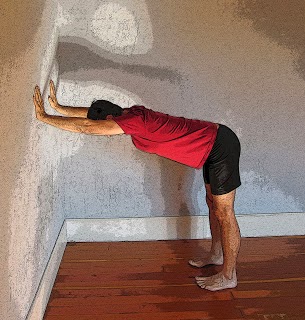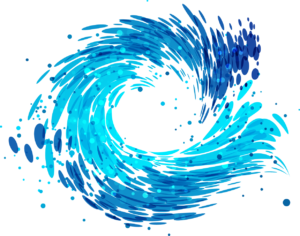by Nina
 |
| Substitute for Downward-Facing Dog |
Yesterday I wrote Cheating at Yoga? about props and how we here at YFHA staff feel it is wise to use them to adapt poses to your body type and/or physical condition. But there are some physical conditions where a prop won’t help. In this case, you can simply modify your poses in certain ways to make them accessible to you.
I was thinking about this because recently a friend told me that she “can’t do yoga” anymore because of a shoulder injury (as yet undiagnosed). I assured her that she still could because there were a lot of poses that she would still be able to do. She then asked if there were some yoga videos for yoga without arms, and I said that I couldn’t think of any but that most practices (except Sun Salutation practices) could be modified by changing your arm positions or, in some cases, substituting one pose for another. I know all about this because I’ve had two frozen shoulders, which meant even moving my arm was very painful, and I continued to go to a public class and kept up my home practice throughout.
Because lifting things caused her pain, I suggested that she avoid all poses where you bear weight on your arms. This would include Downward-Facing Dog, Sun Salutations, and some backbends, such as Upward Bow pose (Urdva Dhanurasana). A modified version of Downward-Facing Dog pose, Half Downward Dog at the Wall, could be substituted for the full pose. Inverted poses, such as Headstand and Shoulderstand, where you bear weight on your shoulders should probably also be avoided. For these, you can do partial inversions, such as Supported Standing Forward Bend and Supported Prasarita Padottanasana (see All About Supported Inversions), where your head rests on a block or other support.
Even after eliminating those poses, there are still so many other poses someone like her could do, including standing poses, seated twists, seated forward bends, and backbends, such as Locust, where your arms do not bear weight.
But what if even just raising your arms over your head or out to the side causes pain? In this case, in standing poses, you can modify your arm position to one that is more comfortable. For poses where both arms are overhead, such as Tree pose (Vrksasana), Warrior 1 (Virabhadrasana), and Powerful Pose (Utkatasana), bring your hands into Prayer position (Namaste) in front of your heart. You can even take this same arm position in poses such as Triangle pose (Trikonasana) and Extended Side Angle pose (Parsvakonasana), where your arms are out to the side. But you could also practice those poses with just the injured arm alongside your body or with a bent elbow and hand on your hip while your uninjured arm is in the standard position. In other words, just find a position that is comfortable for your injured arm. Feel free to experiment!
Surprisingly, seated forward bends, especially if you are flexible and normally hold onto your feet, can also hurt your shoulder. In this case, for the injured arm, reach it only as far as it can go and use a block underneath to support it. Binding in twists is also not recommended, as it is an intense stretch on the shoulder, but most of us know milder alternatives for the arms in twists.
It’s your practice people, so just make it work for you. Like I said yesterday about using props, this is not cheating! You’re still practicing and that’s all that counts.
Follow Yoga for Healthy Aging on Facebook ° To order Yoga for Healthy Aging: A Guide to Lifelong Well-Being, go to Amazon, Shambhala, Indie Bound or your local bookstore.


My as-yet-undiagnosed shoulder pain (I suspect another variation on carpal tunnel, since I spend so much time at the computer) also really bothers me when I do chattaraunga and the pose whose name I don't know, where you clasp your hands behind your back, bend over, and raise your arms. I just basically don't do those poses. Some of the arm raising ones hurt when I do them, but then after practice, I feel better.
Nancy, it sounds like you're doing a good job of looking after yourself, but I would still recommend getting a diagnosis. Knowing what the problem is can make a big difference on what steps you take next to help yourself, including which yoga poses you do or do not practice. —Nina
I modify, modify, modify as my side where I had my pacemaker implanted (left) I have range of motion, and achy-ness issues. It allows other people to modify too, as I teach a gentle class and a chair class. Thanks y'all for all the great articles. Gaileee
I have come to believe that any body can do yoga. I don't know about DVDs, but there are certainly lots of yogis who are missing limbs — some are returned soldiers, others who's lost limbs to cancer or accidents, others who have limbs that don't function fully due to paralysis or palsy. As a yoga therapist, I've been lucky enough to witness and support folks in these situations, as well as the frozen shoulder and injured wrist. I love your bottom line — "it's your practice people" — as a reminder that we should avoid our own suffering in yoga and use all the limbs of yoga to decrease suffering in ourselves and others. Thanks!
I love your writings – thank you so much for all your offerings!
I agree with all the modifications you mention but I also think it's important to mention that if there is a decrease in a range of motion (like in shoulder flexion as you mention in your article) then modifying when there is pain is a great idea – but it's also important to work toward getting that range of motion back (whether it's with PT or Yoga). I have seen many Yogis avoid certain movements because of injury/pain and then never returning to the movements, which can create such an imbalance in the body. Shoulder injury and pain from raising arms overhead is a great opportunity to work with a PT or a knowledgeable Yoga therapist on the most efficient way to raise the arms once the pain subsides. It's a great time to re-teach the body how to do something so "simple" by learning to deepen the head of the humerus into the shoulder joint even when raising the arm – this will prevent future pain and injury as well!
Much luck with your shoulder, Nancy! And many blessings to all of you – thank you again for your words :)
Accessible adaptive chair yoga to the rescue!
Plus a good visit to the PT might be very beneficial!